Chamomile tea is so good for many ailments! Remember The Tale of Peter Rabbit? After eating everything in Mr. McGregor’s garden, Peter got sick to his tummy and his mother dosed him with chamomile and put him to bed. Mother Rabbit was definitely on to something.
Dating back at least 2000 years to the ancient Egyptians, people have used dried chamomile flowers for medicine, cosmetics, and perfumes. The herb derives its name from a Greek word meaning “earth apple,” for the sweet, apple-like aroma of the dried flowers.
Chamomile’s Healing Power
Chamomile has a time-honored reputation for calming anxiety, promoting sleep, and settling queasy stomachs. The tea is also widely used for:
- Washing cuts, acne, and mouth sores.
- Gargling to ease scratchy or sore throats.
- Calming infant colic.
- Easing menstrual cramps and urinary tract spasms.
- Steaming (standing over a simmering pot of chamomile tea and breathing the vapors) to help loosen and soothe plugged sinuses.
- An infusion of chamomile can help a sunburn.
The essential oil of chamomile also often appears as a primary ingredient in healing skin creams and lotions.
Brewed strong and used as a leave-in hair rinse, chamomile temporarily helps bring out blond highlights.
Chamomile’s numerous “bioactive” compounds have attracted the attention of pharmaceutical researchers, who suggest that the herb has a bright future, potentially preventing or treating inflammatory conditions, diabetes, seizure disorders, cancer, osteoporosis, and others. However, they caution the need for much more research before clinical use and prescription of the herb or its extracts.

Growing Chamomile
Two species within two separate genera of the aster family are commonly called chamomile: Roman Chamaemelum nobile and German Matricaria chamomilla. They’re used pretty much interchangeably for medicinal purposes, with the Roman variety used primarily for teas and infusions, the Roman variety for distilling the essential oil
German chamomile, a low-growing annual, is more commonly grown in American gardens. It’s easy to grow, even in far-northern gardens. It self-sows readily and dries quickly.
But the flowers are tiny, so if you really take to the tea you may want to buy it in tea bag or bulk form. However, if you have the space for a large patch you might want to purchase a chamomile rake.
Chamomile is considered one of the safest among commonly used herbs—safe enough for infants and small children.* The main caveat: People with allergies to ragweed and other members of the (very large and diverse) aster family should probably try it in small doses before adopting it as a favorite brew.
I have a ragweed allergy myself (which I’ve had great luck treating with freeze-dried nettle capsules), but I’ve never had a reaction to chamomile. I drink a lot of it, especially on cold, winter nights, when I’m snuggled up in my recliner by the woodstove or soaking in a hot bath.
Mmmm. Think I’ll brew a mug right now.
*Consult your family healthcare professional before treating children with herbs. And don’t use honey as a sweetener in any product for children younger than two years of age.
Learn more about edible flowers!
